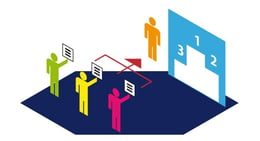What Is Procurement 4.0?
Brian Hoey - September 08, 2020

The progression towards Industry 4.0 is usually described like so: The first Industrial Revolution involved the transition from handmade goods to machine-made. The second involved the introduction of electricity into production plants. The third occurred when computers entered the manufacturing sphere, and the fourth is Industry 4.0—i.e. the smart, digital factory that modern manufacturers are driving towards across the board. Naturally, each of these stages changed the nature not just of industry as a whole, but of each component activity that leads to the creation of a finished product.
Procurement, for instance, went from being a function that had to be managed in person or by mail, to something that could be powered by phone or email. As Industry 4.0 continues to gain steam, of course, procurement will have to continue evolving, and ultimately replace phone calls and email messages with more fully-integrated cyber-physical systems. The question is: what will that actually look like, and what can manufacturers and other supply chain businesses do to make it happen?
Procurement in the Industry 4.0 Era
In the Industry 4.0 era, the entire production chain is ostensibly going digital. Planners can monitor production runs in real-time from the comfort of a supply chain control tower, and the positions of trucks, containers, and even pallets up and down the logistics chain can be easily accessed. In this way, you can not only visualize but analyze the end-to-end supply stream—tweaking, refining, and optimizing networks and plans even as they’re already underway. The more thoroughly integrated each touchpoint is into this paradigm, the more effective every other process becomes.
Obviously, procurement needs to fit into this transformation in a serious way, and studies show that most businesses rate their digital procurement processes pretty highly. Unfortunately, those same studies show that in point of fact most of those companies don’t actually have a high level of digital maturity when it comes to procurement. Sure, some of them have digitized the process, such that they’re no longer sending faxes to and from suppliers to lock in rates and volumes, but few have really transformed the process in a way that’s consistent with Industry 4.0 technologies and principles.
This presents an issue from a production planning perspective: how can you maintain flexibility and stay reactive to incoming orders, demand fluctuations, and other changing conditions if you can’t use the same tools and techniques for sourcing raw materials? You might have a digital representation of your factory floor that’s integrated with advanced predictive and prescriptive analytics—such that you can visualize different planning scenarios in real time—only to find that those planning workflows are stymied by the fact that you simply don't know how quickly you can get the parts you need, whether you can secure the right volumes, and how much it’s going to cost you. Though you’re working with increasingly sophisticated planning software, you can’t actually generate better plans. Why? Because there’s too much upstream uncertainty.
How Digital Transformation Powers Smarter Procurement
To avoid the fate we described above, procurement needs to undergo a digital transformation on the same level as production and logistics planning. This means a scalable digital platform for visualizing your purchasing options, tracking them over time, and choosing the right ones for any given planned production program. To make this happen, you need to be able to take in data from your suppliers in a streamlined and automatic fashion, and you need to connect that data to platforms that integrate with other touchpoints on the planning chain. This can seem daunting, but the results are hard to argue with.
For instance, you might have an application that’s integrated with your various suppliers’ IT solutions, such that you can compare prices and lead times in real time from the comfort of a procurement module. You could filter the results based on your particular needs, and by different plans and planning horizons, in order to figure out the best procurement options in the moment. Naturally, this would integrate with other planning modules downstream in the value chain, meaning that as soon as you made a purchase that data would be available to other planners in inventory, logistics, etc. The result is that rather than having a difficult to access paper trail for each purchasing decision, you instead have a digital representation of your procurement activities that automatically connects to the larger digital representation of your entire supply chain. From there, you can run advanced analytics to get even smarter and more responsive. This might take the form of predictive workflows that estimate potential future price fluctuations and show you the outcomes of potential planning horizons—or it might mean prescriptive analytics that analyze your entire supplier network to find areas of redundancy or waste.
Challenges in Procurement 4.0 Implementation
Okay, let’s say you’re convinced. Procurement 4.0 has the potential to bolster your other digitization efforts and seems like a good area of focus—what next? Well, there are a handful of pitfalls you need to watch out for. For starters, you need to make sure that all of your stakeholders' needs are being accounted for in the selection process, otherwise you might find that one department won’t use and thus can’t integrate with the functionality being deployed at other touchpoints. By the same token, you need to be certain that you’re adopting a solution that actually networks and interoperates with other IT in a way that maximizes visibility.
Once you’ve selected a vendor and some purchasing management software, you’ll see how easy or difficult integration is—just as you’ll see how easy or difficult it is to get users to actually make use of all its functionality. How easy or difficult this is may depend, at least in part, on how much data the software is actually collecting and quickly it’s able to process it. If, within the context of a larger Industry 4.0 deployment, your procurement solution is gathering information from a host of sources up and down the supply chain and making that data available and usable to planners, you’ve got a good chance of achieving a true Procurement 4.0 deployment.
If you want to learn more get your Guide to Industry 4.0:
LATEST POSTS
- Understand Why Production Planning Needs Specialized Solutions
- Understand Circular Economy in The Manufacturing Industry
- How Can Industry 4.0 IT Integration Be Achieved Smoothly?
- The Significance of Order Sequencing in Discrete Manufacturing
- How to improve your Supply Chain Management: The Power of Control Towers



